Dozens of federal, state, and local laws govern the residential rental industry and the landlord-resident relationship. All of these laws are important. The following calls to your attention ten important laws for you to know and follow when you’re a landlord.

The Fair Housing Act
The Fair Housing Act prohibits you from discriminating against applicants or residents based on any of the seven protected classes:
- Race
- Color
- Sex
- National origin
- Religion
- Handicap
- Family status
The Fair Housing Act establishes only the minimum protections. States and localities may set additional protected classes, such as source of income — whether a person’s income is from a job, alimony, child support, unemployment, welfare, disability payments, and so on.
The Fair Credit Reporting Act
According to the Fair Credit Reporting Act (FCRA), you may use credit reports to evaluate rental applications. However, if you deny housing to an applicant based on information contained in the credit report, you must provide the applicant with an adverse action notice that includes the following information:
- The name, address, and telephone number of the credit-reporting agency (CRA) that supplied the credit report, including a toll-free telephone number for CRAs that maintain files nationwide
- A statement that the CRA that supplied the report didn’t make the decision to take the adverse action and can’t give the specific reasons for it
- A notice of the applicant’s right to dispute the accuracy or completeness of any information provided in the credit report, and the applicant’s right to a free report from the CRA upon request within 60 days
The FCRA also comes into play if you want to report the nonpayment of rent to one or more CRAs. If you report a resident for nonpayment of rent and the resident cures the debt, you’re legally obligated to update the resident’s credit report to indicate that the debt has been cured.
The implied warranty of habitability
The implied warranty of habitability requires that landlords provide residents with living space that’s fit for human occupancy. To be habitable, living space must have heat when it’s cold, running water, a sufficient amount of hot water, plumbing and electricity that function properly, and so on. Landlords must also maintain clean and sanitary buildings and grounds — free of debris, filth, rubbish, garbage, rodents, and vermin.
If a rental unit is uninhabitable, residents have the right to withhold rent until the necessary repairs are made or, in more serious situations, terminate the lease.
Although your residents are responsible for repairing anything they or their guests break, you’re required to perform any repairs required to maintain fit and habitable living conditions, and you must complete the repairs in a reasonable period of time.
The mutual covenant of quiet enjoyment
Implied in every lease and rental agreement is the mutual covenant of quiet enjoyment, which grants all residents the right to the undisturbed use and enjoyment of the rental property. This covenant applies to you, as landlord, in two ways:
- You’re not allowed to enter a resident’s unit whenever you want. You can enter in an emergency that threatens life or property, when you ask and the resident gives you permission, and to perform necessary inspections or repairs or show the unit to prospective renters or buyers (only after giving the resident sufficient notice).
- You need to reasonably investigate complaints and potentially take action against any resident who’s disturbing his neighbors.
Your state’s security deposit rules
Every state has a security deposit statute that typically specifies the following:
- How the security deposit is to be held — usually in an interest-bearing account in an in-state bank
- What the security deposit may be used for — usually to cover unpaid rent, damage beyond ordinary wear and tear, and cleaning to make the unit as clean as it was when the resident moved in and sometimes to repair or replace the landlord’s personal property in the unit if that use is mentioned in the lease
- When the unused portion of the security deposit must be returned to the resident
- That the landlord provide an itemized invoice of any money deducted from the security deposit
Disputes over security deposits are common and frequently lead to the resident taking legal action against the landlord. To protect yourself, comply with your state statute, and take the following precautions as good business practices, even if it isn’t required under the applicable statute:
- Have a separate interest-bearing account for holding security deposits.
- Complete a move-in/move-out checklist to document the condition of the property at the beginning and end of a resident’s stay.
- Take photos or video of the property to create a visual record of the property’s condition at the beginning and end of a resident’s stay.
- Keep receipts for all repairs and cleaning required to prepare the unit for the next resident, even though you’re permitted to charge the resident only for damage beyond ordinary wear and tear, and cleaning to make the unit as clean as it was when the resident moved in.
- Return the unused portion of the security deposit to the resident as soon as possible as required by state law.
- Along with the unused portion of the security deposit, include an itemized list of all costs deducted from the security deposit.
The Residential Lead-Based Paint Hazard Reduction Act
The Residential Lead-Based Paint Hazard Reduction Act, in part, requires that landlords inform residents of the hazards posed by lead-based paint. If your rental property was built prior to 1978 (the year the EPA banned lead paint) you’re required by law to do the following:
- Disclose all known lead-based paint and lead-based paint hazards and any available reports on lead in the property.
- Give renters the EPA pamphlets “Protect Your Family From Lead in Your Home” and “The Lead-Safe Certified Guide to Renovate Right.”
- Include certain warning language in the lease as well as signed statements from all parties verifying that all requirements were completed.
- Retain signed acknowledgments for three years, as proof of compliance.
- Units that have no bedrooms, such as lofts, efficiencies, and studio apartments
- Short-term rentals of fewer than 100 days
- Housing designated for the elderly or the handicapped unless children live or are expected to live there
- Property that’s been inspected by a certified inspector and found to be free of lead-based paint
Housing that is exempt from this rule include the following:
State-required disclosures
In addition to the federal lead-based paint disclosure, many states require that landlords disclose one or more of the following:
- Environmental hazards, including periodic pest control and herbicide treatments, toxic mold, asbestos, radon gas, bedbug infestation, and methamphetamine contamination
- Recent flooding or location in a flood zone
- Security deposit policies and procedures
- Nonrefundable fees, such as a pet fee, where such fees are allowed
- Smoke detector location and maintenance requirements
- Nearby military ordinance, such as a US Army base
- Smoking policy
- Landlord’s or property manager’s name and contact information
- Any shared utility arrangement
Your state’s Landlord Tenant Act
Nearly every state has a version of the Landlord Tenant Act, which defines the rights and obligations of the landlord and the tenant (also known as the resident), legal remedies for breach of contract, possible defenses to legal actions, and much more. To find your state’s landlord tenant act, search the web for your state’s name followed by “landlord tenant act” and click one of the links that looks promising. If that doesn’t work, track down your state’s official website, and search that site specifically for something like “landlord tenant” or “residential rental laws.”
Eviction rules and procedures
If you need to evict a resident, turning off electricity, gas, and water to the unit to compel the resident to leave is illegal. You must follow your state’s eviction rules and procedures, which typically require that you perform the following steps:
1) Check your state’s landlord tenant act to find out whether you have legal grounds to evict the resident.
2) Give the resident reasonable notice of your intent to file for eviction, including the reason you intend to do so and, if required by state law, the time the resident has to address the issues.
3) Wait until the morning after the deadline specified in your notice, and then file for an eviction hearing at your county’s courthouse.
4) Assuming you prevail in court, wait until the day after the court’s deadline for the resident to move out, and if the resident hasn’t moved out yet, call the sheriff to evict the resident.
Failure to follow your state’s eviction process could result in your losing your case. The resident may end up living in the property for some time, perhaps without paying rent. In addition, the resident may be able to file a legal claim against you in civil court and force you to pay damages, legal fees, and penalties.
Mitigation of damages
When a resident breaches a lease, for example by moving out three months into a one-year lease, the resident is obligated by the contract to continue to pay rent. However, you can’t just let the unit remain vacant for nine months. You’re legally obligated to take steps to mitigate (lessen) the resident’s losses. In this example, ways to mitigate the damages include:
- Accepting a replacement the resident recommended to rent the unit for the months remaining on the lease, assuming the recommended replacement qualifies
- Advertising the unit to find a new resident, screening applicants, showing the unit to qualified applicants, and so on
Gather evidence of your attempts to re-rent the property, such as advertisements, records of applicants you screened, and dates on which you showed the property to qualified applicants.



